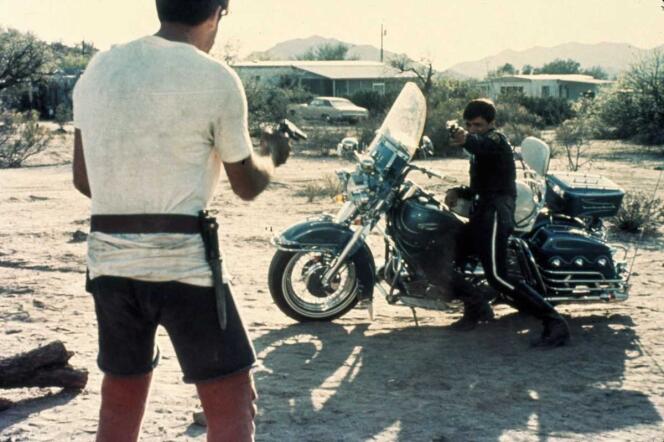TCM CINÉMA – SATURDAY NOVEMBER 18 – 8:50 P.M. – FILM
Among the avatars of the road movie, a genre historically linked to the history of American counterculture, one of the most astonishing is Electra Glide in Blue (Controlled skidding in French). Directed by James William Guercio in 1973, released in theaters only in 2010, it suffers from the unfortunate reputation of being the sociopolitical counterpoint ofEasyRider (1969) – in a way his reactionary alter ego.
It is true that Guercio pulls no punches. The title of his film, to begin with, refers to this mythical monster manufactured by Harley-Davidson, which the American police were then equipped with. Its hero is a policeman named John Wintergreen (Robert Blake), whose probity is matched only by courage, a zealot of the Star-Spangled Banner who practices shooting on a poster ofEasyRider and who will fall under the bullets of a hippie.
Electra Glide in Blue is not so much a manifesto against youth as a lament, often ironically melancholy, of the lost greatness of America and the division of its people. Wintergreen personalizes her first and foremost, by bringing together perfectly contradictory traits: an accomplished lover, cultivating his body and his mind, he is also a midget who barely keeps up with his colleagues. Wintergreen is a dwarf who thinks he’s Superman.
Both the story and the direction of the film cultivate this paradox. Aspiring to defend the law with exemplary integrity, Wintergreen comes up against the intolerance, stupidity and racism of his colleagues as much as the degeneration of a Flower Power converted to pure drug trafficking and generalized degradation. from all directions.
Political lynching
The aesthetic also carries an irreconcilable divide: on the one hand, the setting of John Ford’s westerns, this Monument Valley filmed in wide shot which refers to the great American myth; on the other, interior sequences which fragment and dehumanize individuals through tight editing, reducing them to their symbols (leather jacket, female breasts molded into a bodice, gleaming weapons, impeccable uniforms, etc.).
The story of this film, more bitter than fascistic, is that of a dream of collective grandeur reduced to the dimension of a list of fetishized accessories. The bad fate meted out to it upon its release, between the indifference of the general public and the political lynching which targeted its director, will also have contributed to making it a unique film. James William Guercio was in fact a complete neophyte when the United Artists studio, eager to repeat the smoldering financial blow ofEasyRiderentrusted him with $1 million to make a road movie.
You have 10% of this article left to read. The rest is reserved for subscribers.
